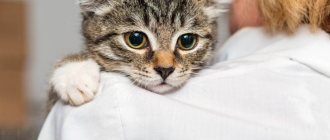5909Administration
A newborn kitten is always a joy for all inhabitants of an apartment or house. You need to prepare for it in advance. Despite the fact that a cat knows at the genetic level how to survive in nature, it is not always able to survive this process on its own. Therefore, every cat owner should know what to do if the cat cannot give birth.
There are cases when, if help was not provided, a pet began to die from various complications. This usually affects artificially bred breeds that have undergone changes at the genetic level and cannot reproduce normally. Therefore, they are not able to cope with what ordinary yard animals can easily cope with.
© shutterstock
How is childbirth?
The process begins with the cat's loud meowing, with which she tries to calm herself down. Then the water breaks and contractions are observed. They gradually increase until the cervix opens. After its opening, they acquire a rhythmic character, which indicates the imminent appearance of offspring. During childbirth, a water bladder initially appears, after which the head and then the limbs of the first baby emerge from the vagina.
Kittens are born at intervals of 30 minutes, sometimes 60. You can understand that labor has stopped and the pet has given birth to the last kitten by feeling the abdominal cavity. Next, owners need to examine all kittens and make sure that the cat has removed the bladder from them. Attention should also be paid to the amount of placenta, which should correspond to the number of babies. The umbilical cord is also subject to examination, which during childbirth the cat often chews on its own.
Physiology of pregnancy and childbirth in cats
- Short-haired and hairless breeds carry their offspring for approximately 55–65 days.
- Long-haired females – up to 75 days.
Pregnancy in cats lasts from 60 to 75 days.
The duration of pregnancy depends on the number of kittens. The more babies a mother has inside, the faster labor can occur. Conversely, one or two babies may be born late.
Conception usually occurs after 25–50 hours, from which point it is customary to begin the countdown.
Phases of pregnancy
On the fiftieth day, the kittens begin to move actively.
- On the twentieth or thirtieth day, the nipples begin to rise and become rounded. They turn pink and begin to peel off. The animal sleeps more, becomes more cautious, moves less, and begins to eat more. The abdomen increases by about one and a half centimeters, becomes rounded, elastic, and the embryo can be felt.
- At the beginning of the fifth week, the volume of the abdomen is approximately two and a half centimeters, the volume of the fetus reaches three and a half centimeters.
- At the beginning of the sixth week, the fruits descend into the peritoneum and stretch out, becoming cylindrical in shape. The belly gets bigger if there are more than two kittens inside. If there are one or two babies inside, the belly remains practically unchanged. It is strictly forbidden to palpate the female’s peritoneum at this time in order to avoid damage to the fruits. After the sixth week, the abdominal area increases laterally and takes on the shape of a pear.
- Starting from the fortieth day, accelerated development of the fetus occurs and fur is formed, which for the mother may mean a decrease in appetite.
- On the fiftieth day, the kittens begin to move actively. The harbingers are considered to be relaxation of the pelvis, and increased mobility of the sacral bone, swelling of the vulva and mucous discharge, and the appearance of colostrum. At this time, the cat is actively looking for a secluded place to build a nest.
Causes of problems
If an animal is overweight, it can cause problems during the birth of offspring.
It is not difficult for a pregnant pet to give birth at home. However, there are situations when a long period has passed since the start of contractions, but the pet does not give birth for a long time. Often, a cat cannot give birth in the following situations:
- large size kitten;
- malposition;
- traumatic injuries;
- inflammation;
- narrow pelvis;
- incomplete dilatation of the cervix;
- abnormalities in the development of the vaginal vault;
- lack of lubrication;
- advanced age;
- excessive body weight.
Weak labor
However, often a cat cannot give birth due to the influence of the factors described above. One of the most common factors is considered to be weak labor. It is usually divided into 2 types:
Weak uterine contractions are possible when the pet’s body does not produce enough oxytocin.
- Primary light tone of the uterus. It is observed due to a lack of the hormone oxytocin in the body, which is responsible for the frequency of contractions. Sometimes this condition can be caused by a lack of calcium.
- Secondary. Cessation of uterine contractions due to severe exhaustion of the female during labor.
What signs can you use to know that a cat is about to give birth?
A cat, just like a person, has certain signs that indicate impending birth:
- The animal is constantly kept in a box or on a bedding specially designed for childbirth.
- The cat moves around the house only to drink food or water, the rest of the time it lies and sleeps.
- If the owner gives hard and heavy food, she may refuse it completely, as an overfilled stomach leads to discomfort or pain.
- The external genitalia swell and become red.
Pregnant cat
- A small amount of red or yellow mucus may be released.
- Reddening of the nipples, the beginning of colostrum secretion, this indicates the established process of lactation.
- A few hours before the cat lambs, her mucous plug comes out, this indicates the beginning of the birth process.
- At the beginning of active contractions, the cat begins to meow loudly and protractedly.
- Often the animal tries to leave the family place, to hide from people, this should not be allowed so as not to harm the offspring.
Important! To avoid unpleasant consequences, you can first agree with a veterinarian to provide assistance during labor. There are clinics where a doctor can visit your home even at night
What to do at home?
How to induce labor at home?
To help a giving birth cat and speed up the birth process, it is recommended to use the drug Oxytocin. It is an artificial hormone that makes the uterus contract faster. However, this medication is not safe, so the first thing you need to do before using it is to contact the veterinarian who saw the pregnant cat. Improper use of the medicine may cause severe bleeding or cervical rupture.
The drug Travmatin will help speed up and relieve the pain.
You can also use another pharmaceutical product called “Travmatin”. If the owner sees that the cat is in pain, this medicine is perfect. It has an analgesic effect and allows you to regulate contractions. In addition, in veterinary practice the medication is used to prevent complications.
A pharmaceutical product called “Gamavit” will also help. In veterinary medicine, it is used to stimulate the muscles of the uterus. Often used in difficult situations to make the birth process easier and faster. It is also recommended to resort to calcium gluconate, which smoothly enhances labor and also provokes increased production of breast milk. This medication can also be used after the birth of offspring, as it effectively fights eclampsia. This pathology develops after childbirth and is a nervous disorder. Often the disease is caused by a lack of calcium in the body of the cat who gave birth.
The lack of this element not only affects the condition of teeth, bones and coat. It can also provoke seizures and lead to the death of your pet.
ethnoscience
For a homemade stimulating cocktail you will need an ascorbic acid preparation.
To induce labor, the owner will first need to put the pet in a position as if she is defecating, and then begin to massage the peritoneum. Next, it is recommended to prepare a cocktail that can be used instead of Oxytocin. You will need to fill the syringe with 2 ml of ascorbic acid, 4 ml of calcium gluconate and glucose. To force a cat to give birth, the injection must be given intramuscularly, but only before the first baby appears. The dosage is calculated as follows: 2 ml of the product per 10 kilograms of the pet’s body weight.
The cat can't give birth
When the animal strains, but this does not help, veterinarians recommend resorting to the medications described above. If, with the help of medications, the pet is unable to give birth, it is important for the owner to call a veterinarian as soon as possible or take the cat to the clinic. This is an important condition, since sometimes the pet requires resuscitation, otherwise it may die.
Kitten stuck
To carry out this manipulation, you should use Vaseline.
If the baby's head has already appeared, but the cat is unable to push it out, the owner will need to arm himself with Vaseline and sterile gloves. When a kitten is stuck in the birth canal, you need to carefully lubricate the vagina, then insert your finger into it and find the elbow folds of the cat's paws. The owner should grab both limbs and gently turn the baby from side to side, trying to move the paws forward.
Situations are not excluded when the afterbirth does not come out. In this case, you will also need to take sterile gloves, after which you need to insert your finger into the vagina, try to feel the afterbirth and remove it. If you can’t cope on your own, a veterinarian’s intervention is required. When a bubble has emerged, which often breaks inside the female, it should be broken independently, but your hands should first be disinfected.
A kitten is born dead
The baby will begin to breathe again after the passages are cleared of accumulated fluid.
If the owner discovers such a situation, it is important not to panic. Babies may only appear dead, which is often observed when the airways are blocked. To revive the cat, you need to use a pipette to clear the pathways, and then stimulate breathing by holding it by the limbs and holding it upside down. Next, the baby should be placed on the cat's chest. However, there are situations when kittens are actually born dead. If the cat has already given birth to 2-3 dead babies, and when you feel her peritoneum you can find another fetus, you need to visit a veterinarian. Sometimes a caesarean section is required.
What to do if the cat cannot give birth on her own
If a cat has insufficient contractions, they can be induced by stroking the animal's stomach and back with your hand.
If the kitten is stuck in the birth canal, it is necessary to pull it out. You need to pull it out carefully, you cannot pull the head, this can lead to fractures of the cervical vertebrae and the kitten will die. It is safer to pull on the folds of skin on the body or neck, or on the paws, alternately to the left and then to the right. In case of dry birth and leaked amniotic fluid, lubricate your fingers with Vaseline, and then begin to pull the kitten out. Try to pull the kitten along the cat's body, supporting the mother's abdomen with your other hand.
Necessary preparation
Despite the fact that giving birth to a cat is a natural process, the owner of the animal will face considerable troubles. A cat living at home needs to create a special environment for the birth of offspring, provide veterinary care if necessary, “meet” new residents and make sure that they and the mustachioed mother have enough nutrition.
Arrangement of the “room” for childbirth
Arrangement of the place
If you do not prepare a place for the cat to give birth in time, she will find it herself. This is not always convenient, since a cat is a secretive animal, and it will hide with special care. Some cats leave home altogether and return, bringing kittens one at a time.
The ideal cat place would be a box or large basket with high walls. This could be a house from a pet store, a cardboard box, or even a cabinet drawer. It is important that it is sufficiently closed and spacious, but at the same time not too large - the expectant mother should feel safe and calmly feed the kittens.
Place the “maternity ward” away from drafts, bright light and doors: the place should be secluded and darkened. Place an old small mattress at the bottom of the box or drawer, then lay down an oilcloth, and place a regular baby diaper on top.
A quiet, cozy place where the cat will not be disturbed
Important! It is worth showing the cat the place in advance. If she still stubbornly seeks shelter, ignoring the prepared place, you should take her to the box when the birth process has already begun.
What materials, tools and medications may be needed
You need to thoroughly prepare for childbirth. To do this, you will need not only to arrange the place where the kittens will appear, but also to prepare some tools and materials that may be needed in case of complications that arise. In addition, you should make sure you have medications on hand.
For home birth you will need the following:
- telephone number of a veterinarian who can be contacted at any time;
- clean strips of fabric - you can tear a cotton sheet;
- disposable diapers; sterile threads (pre-soaked in alcohol); sterile scissors with blunt ends (can be boiled for 10-20 minutes);
- gloves;
- alcohol antiseptic or alcohol for hand treatment;
- container for placenta;
- warmer;
- baby bulb or pipette for suctioning mucus.
- healing ointments, for example, Levomikol, Vaseline, oxytocin, potassium gluconate.
You should prepare as much as possible for childbirth, so as not to be terrified of searching around the house for everything you need.
Prepare everything you need in advance for cat and kitten hygiene
When to call the vet
During childbirth, critical situations may arise that can only be resolved in a clinical setting. This:
- More than a day has passed since the first contractions;
- it is not possible to independently remove a stuck kitten from the birth canal;
- there are no precursors of the onset of labor, although more than 65-70 days of pregnancy have already passed;
- the cat has a high or, conversely, low body temperature;
- the animal does not strain or move, breathing is weak;
- contractions are strong, but the kitten does not appear;
- unpleasant-smelling contents mixed with pus and blood are released from the birth canal.
Caesarean section during childbirth
Cat after birth
What to do after giving birth to a cat?
This is also a popular question among owners. The birth can be considered complete if, 1.5 - 2 hours after the birth of the last kitten, the cat has no contractions, the stomach is soft and all the placenta have come out. During this period, the main thing is to feed the cat properly and protect it from stress.
When can a cat become pregnant after giving birth?
Owners often ask how quickly a cat can become pregnant after giving birth and can a cat become pregnant immediately after giving birth? It must be taken into account that giving birth and feeding kittens is a huge burden on the cat’s body, which exhausts the animal and can lead to diseases.
The maximum number of births a cat can give birth to is once a year. In this case, the cat has the opportunity to recover from previous births and raising kittens.
When can a cat be spayed after giving birth?
Sometimes owners are interested in whether it is possible to sterilize a cat after giving birth and when can a cat be sterilized after giving birth? Veterinarians cannot answer this question unequivocally. The answer to the question of how long to sterilize a cat after giving birth depends on whether the cat is nursing kittens. If your cat is nursing kittens, you should not spay her immediately after giving birth. As a rule, veterinarians say that a cat can be sterilized no earlier than 2 months after birth. Sterilizing a cat after birth is fraught with serious complications (including death) and is possible only in exceptional cases.
The cat does not have milk after giving birth
There are several reasons why a cat does not produce milk after giving birth:
- Stress.
- Infection. In this case, treatment with antibiotics is necessary.
- Lack of maternal instinct - occurs, as a rule, in a young cat.
- Poor nutrition. Give your cat more dairy products, vitamins and protein.
- Hormonal imbalance.
In any case, you need to contact a specialist and follow his recommendations.
What to feed a cat after giving birth
Many owners are concerned about the question of what to feed their cat after giving birth. How to feed a cat that has given birth?
During the first 10 to 12 days after birth, the diet of a nursing cat should include only nutritious, natural and easily digestible foods: fermented milk, cereals and vegetables. If your cat really lacks meat, you can give boiled dietary meat.
It is better to exclude dry food: a large amount of salt and a small amount of liquid makes it difficult for a cat to produce milk after birth. However, if a cat has allergies, a sudden change in diet is contraindicated. In other cases, familiar foods are introduced into the diet of a nursing cat on the 14th day. Please note that after giving birth, your cat needs to be given foods that contain magnesium and calcium. Ask your veterinarian which supplements to choose.
It is important that food for a nursing cat is always fresh. Water must be freely available










